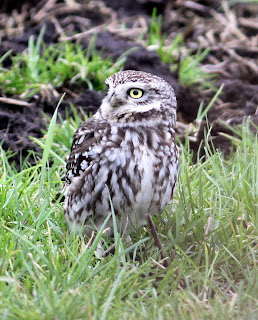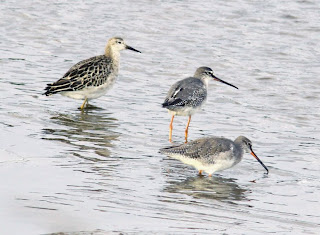Although the BBC's prognosis was for a wretched morning it wasn't nearly so bad as they suggested, the increasing wind speed slowly clearing the grey skies to make a half decent if somehat rain-speckled morning.
It was 9 am before I reached Conder Green where noisy panicking waders greeted me. A Barn Owl was hunting the marsh where Redshanks and Oystercatchers have young tucked away, the adults' noisy warnings serving as a cue for others to join in. From the lay-by I could see the owl patrolling about ten or twelve feet above the tidal ditches, every so often dropping lower and out of sight. Now if I had been on the other side of the marsh and in the front room of the house alongside the road I think better pictures might have ensued. Anyway Barn Owl is certainly a good bird to get on someone's “house list”. But by now traffic was building up and the owl quickly forsook the marsh and flew off to a daytime roost.
Barn Owl at Conder Green
The muggy morning and a healthy crop of insects had brought hirundines and Swifts down to eye level with 12 Swift, 14 House Martin, 6 Swallow and 4 Sand Martin noted. An hour or so later the Swifts had increased to 20+ with most of the Swallows and all of the Sand Martins gone.
Passerines seen and/or heard comprised 2 Pied Wagtail, 2 Whitethroat, 2 Reed Bunting, 4 Tree Sparrow, 1 Sedge Warbler and 6 Goldfinch. There are young but not yet independent Goldfinches about now, the fledglings staying all the time with the parents and making lots of noise as they beg for food. The young Goldfinches are in our own garden too and as soon as the wind drops I'll be able to catch a few for marking.
Goldfinch
A few more waders today in the shape of 6 Curlew and 5 Black-tailed Godwits in addition to the expected 15 Redshank,10 Oystercatcher and 6 Lapwing.
Wildfowl remain at 2 Canada Goose with young, 12 Shelduck, 14 Tufted Duck, 1 Teal, 1 Pochard 1 Great Crested Grebe and 1 pair of Mallard with 4 young. Now is a good time of year to see the "tufts" on a drake Tufted Duck.
Mallard
Tufted Duck
A quick scoot around Jeremy Lane found 15 Lapwing, 6 Oystercatcher, 2 Pied Wagtail, 2 Greenfinch, 1 Sedge Warbler, 1 Linnet and 12 Skylark. Some of the Skylark are youngsters and others singing adults moving on to second broods I guess.
Skylark
By now the rain was returning so I headed home, on the way passing Lane Ends Pilling where a singing Blackcap and a single Jay were close to the road.
Stay tuned to Another Bird Blog for news, views and more new pics. Meanwhile "click the pics" for a grandstand view.
Linking today to Anni who like me would rather be birdin.
Linking today to Anni who like me would rather be birdin.













































































